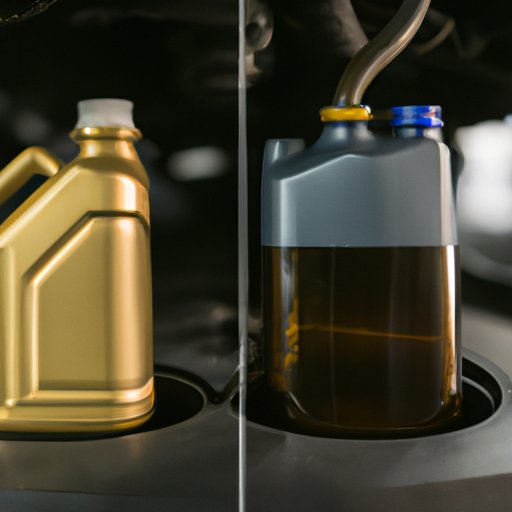
I. Introduction
Changing the oil in your car is one of the most important things you can do to maintain the health and longevity of your vehicle. Not only does it keep your engine running smoothly, but it also keeps your car’s other systems in good working order. In this article, we’ll cover everything you need to know about changing the oil in your car, including tools you’ll need, step-by-step instructions, and common mistakes to avoid.
II. Oil Change 101: A Beginner’s Guide to Keeping Your Car Running Smoothly
Before diving into the nitty-gritty of changing your oil, it’s important to understand why it’s necessary. In short, oil lubricates the moving parts of your engine to prevent friction and keep them from wearing down too quickly. Additionally, oil helps remove dirt and debris from your engine, improving its performance and fuel efficiency.
When it comes to oil, there are two main types: synthetic and conventional. Conventional oil is derived from crude oil and is cheaper than synthetic oil. Synthetic oil, on the other hand, is made from chemical compounds and is more expensive. While both types of oil can do the job, synthetic oil tends to offer better performance and is recommended for newer or high-performance vehicles.
So, how often do you need to change your oil? This can vary depending on your car, driving habits, and the type of oil you use. But as a general rule, it’s safe to change your oil every 5,000 miles or so.
III. Tools of the Trade: What You Need to Know Before Changing Your Car’s Oil
Changing your oil may seem intimidating at first, but with the right tools and a little know-how, it’s a relatively easy process. Here’s a list of the tools you’ll need to get started:
- Oil filter wrench
- Oil drain pan
- Ratchet and socket set
- Jacks and jack stands
- New oil filter
- New oil
Before you get started, it’s important to note any safety precautions. Never change your oil while the engine is hot, and always make sure your car is safely supported on jack stands before getting underneath it.
IV. Step-by-Step Guide: How to Change the Oil in Your Car Like a Pro
Now that you have your tools and safety precautions in place, it’s time to start changing your oil. Here’s a step-by-step guide to help:
- Step 1: Locate the oil filter and oil drain plug underneath your car. Place your oil drain pan underneath the drain plug.
- Step 2: Use your ratchet and socket set to loosen the drain plug and let the old oil drain out completely.
- Step 3: While the oil is draining, remove the old oil filter using your oil filter wrench. Be sure to have your oil drain pan handy as some oil will leak out.
- Step 4: Apply a small amount of new oil to the rubber gasket on your new oil filter. Then, screw the new filter into place by hand.
- Step 5: Once the oil has finished draining, replace the drain plug and close the oil drain pan.
- Step 6: Now it’s time to add the new oil. Consult your owner’s manual to determine how much oil your car requires. Use a funnel to add the oil to the engine, and be careful not to overfill.
- Step 7: Once you’re finished, start your engine and let it run for a few minutes to circulate the new oil throughout the system.
And that’s it! You’ve successfully changed your car’s oil.
V. Common Mistakes to Avoid When Changing Your Car’s Oil
Although changing your oil is relatively straightforward, there are a few common mistakes that people often make. These can include:
- Not tightening the oil filter or drain plug enough, which can cause oil leaks
- Overfilling or underfilling the engine with oil
- Using the wrong type of oil for your car
It’s important to avoid these mistakes as they can be harmful to your car’s health. To avoid them, be sure to double-check your work and consult your owner’s manual for guidance.
VI. The Ultimate DIY Guide to Changing Your Car’s Oil
If you’re serious about maintaining your car’s health, changing your oil is something you should do yourself. Not only will it save you money in the long run, but it will also give you a deeper understanding of your car’s inner workings. Here are some additional tips to help:
- Invest in a quality oil filter wrench and ratchet and socket set
- Consider using synthetic oil for better performance and longer-lasting protection
- Use a funnel to make adding oil easier and cleaner
By following these tips, you’ll be able to change your car’s oil like a pro in no time.
VII. Why Regular Oil Changes are Essential for Maintaining Your Car’s Health
Now that you know how to change your car’s oil, it’s important to understand why doing so regularly is so crucial for your car’s health. Failing to do so can lead to:
- Increased engine wear and tear, leading to expensive repairs or replacements
- Decreased fuel efficiency and performance
- Build-up of harmful deposits in the engine
Additionally, regular oil changes can extend the life of your car and save you money in the long run. So, be sure to make changing your oil a regular part of your car maintenance routine.
VIII. Conclusion
Changing your car’s oil may seem intimidating, but with the right tools and know-how, it’s easier than you might think. By following the steps outlined in this article, you’ll be able to keep your car running smoothly and prevent costly repairs down the line. So, don’t be afraid to get your hands dirty and give it a try!
For more car maintenance tips and tricks, be sure to check out our other articles on car care.





